That Fit Friend is supported by its readers. I [Jake Boly] run this site myself and buy the gear I review. If you purchase through my site, I may earn commissions on sales, read more here!
We could call this article a few things: “Battle of the Classics,” “Millennials vs Gen Z Lifters,” or “Tried and True Classic Showdown.” If you go to any big box gym, there’s a good chance you see multiple lifters rocking Blazers, Converse, or Vans for lifting.
I personally have a special place in my heart with all of these shoes. I’ve competed in powerlifting multiple times with Converse Chuck Taylors, and I’ve worn Vans my entire life — especially during my skateboarding days — and the Blazer Mids have been one of my favorite shoes, training and going out in.
If you’ve been looking for a consistently stable shoe for strength and hypertrophy workouts, then you’ve come to the right place. You can’t go wrong with Nike, Vans, or Converse, but which is best for you? That’s where the devil’s in the details.

Performance Quick Notes
- Which Is Best for Lifting: All can work great, but the Blazer Mid will give you the most flexibility, while the Converse sans its insole will give you the closest-to-the-ground feeling. The stability in all of these shoes is consistent, and you can easily train over 500 lbs in any of these models. The better approach to discussing their lifting performance is factoring in what your lifting looks like.
- Which Is Best for CrossFit: None will work that great. I’ve seen some lifters tackle CrossFit WODs in Converse, but Godspeed to them. All of these shoes lack the versatility and responsiveness you’ll want for any face-paced CrossFit WOD where you’re jumping a lot and transitioning between exercises.
- Which Is Best for HIIT/Versatile Workouts: Nike Blazer Mid will be your best bet. The Vans Sk8-Hi is a little too heavy for any form of versatile workout, and the Converse can work but can lack outsole tread and responsiveness. If you’re going to do anything versatile in these three, the Blazer Mid will be the best option, relatively speaking.
- Which Is Best for Short Runs: None are great. I’d highly suggest not running in any of these models if you value comfort.
- Which Is Best for Daily Wear: All work great. Converse will be your cheapest option, and it looks classic. The Blazer Mid looks great and the most “new school” and has the most flexible and comfortable midsole. Vans Sk8-Hi is also timeless and goes great with jeans and pants; plus, they tend to last forever, even in inclement weather.
If you like a bulkier and more stable shoe with a close-to-zero-drop build, go with the Vans Sk8-Hi. For more flexibility and as a generalist for strength and hypertrophy, go Blazer Mid. If you want to remove the insole and get as close to the ground as possible for deadlifts and powerlifting, grab the Converse Chuck Taylor.

Shop These Shoes
Performance Assessment
For these models, I’m only going to discuss how they do for squats, deadlifts, general lifts, and daily wear. That’s where these excel and where most will be wearing them.
Vans Sk8 Hi vs Nike Blazer vs Converse Chuck Taylor for Squats
For squats, all three of these shoes will provide plenty of stability for most lifters. As in, none of the midsoles and outsoles should compress easily even when working north of 400 lbs. My heaviest squat in these shoes was a 200kg/440 lbs squat in Converse.

To get more granular, there are three things that I think about when comparing these shoes for squats. First, the heel-to-toe drop. A lot of lifter think all of these shoes are zero-drop AKA they have a 0mm heel-to-toe drop, but that actually isn’t the case.
- Nike Blazer Mid: ~5mm heel-to-toe drop
- Converse Chuck Taylor: ~7-8mm heel-to-toe drop (with the insole in)
- Vans Sk8-Hi: 0-2mm (it’s nearly typically perfect)
If you’re someone who likes a little more heel in their shoes, then the Blazer Mid and Converse with the insole in can be a great option. For my true 0mm heel-to-toe drop lovers, the Vans Sk8-Hi and Converse without the insole work fantastic.
Second, is the width of each of these shoes and how they’ll accommodate toe splay. The Vans Sk8-Hi in [wide] is the widest option, the Converse [wide] models come in at a close second, and the Blazer Mid takes third place. If you’re concerned with width and having more room to splay your toes for squats, grab the Vans or Converse models and buy the WIDE options.



Third and lastly, the grip of these models. If you’re training on wooden platforms a lot, the Vans and Nike will give you the most grip. The waffle and herringbone tread patterns on both of those shoes will work well across all surfaces. Converse work fine, but they start to fade and get the fuzzy underlayer that’s under the top rubber overlay on the outsole. For that reason, I don’t love using older Converse for big squats on wooden platforms, so it’s a knock on their long-term abilities.
Winner: All work great. Go Blazer Mid if you need a little more drop, go Vans for a flatter shoe.
Vans Sk8 Hi vs Nike Blazer vs Converse Chuck Taylor for Deadlifts
Similar to squats, from a stability point of view, most lifters will be fine in all of these models. I’ve deadlifted north of 500 lbs in all of these shoes with no issues, and other lifters who are much stronger than me have deadlifted much more than that with no issues.
When considering these shoes for deadlifts the two factors I like to think about are stack height and grip. Stack height entails the amount of material that separates your foot from the floor. To optimize deadlift mechanics for big pulls, you generally want to get as close to the ground as possible. This gives you less range of motion you need to lift weight.

In terms of stack height, there’s a pecking order with these shoes and I also have a pro tip for you. From thickest to thinnest: Vans Sk8-Hi, Nike Blazer Mid, Converse Chuck Taylor.
If you’re a powerlifter or someone who wants to double down on their shoe for deads, get a Converse and take the insole out and swap it with a thinner insole. This will give you a super minimalist-feeling shoe and it will almost replicate a barefoot shoe. Bonus tip, try to keep your pair limited to the gym and their outsole will last longer.
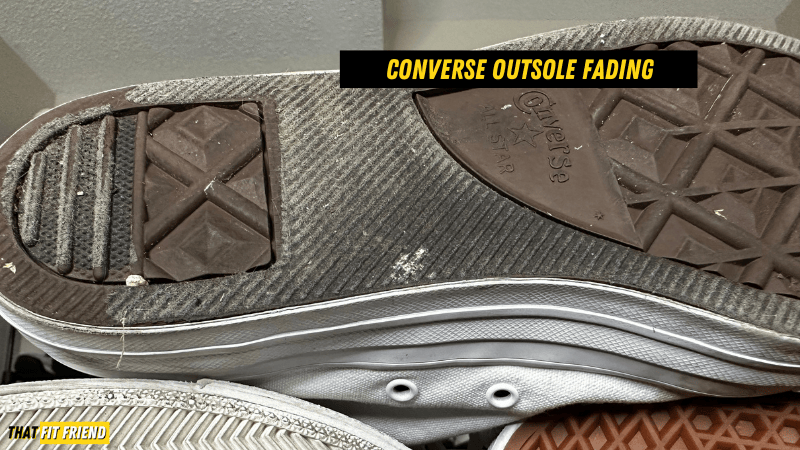


In terms of grip, the Blazer and Sk8-Hi will give you the most bite on all surfaces whether you’re pulling sumo or conventional. Again, Converse work great, too, when they’re fresher. As Converse age they get fuzzy which decreases their bite. Fun fact, this is because Converse are actually labeled as “slippers” when shipped because they don’t have full rubber outsoles. This saves money which is how these shoes can stay so cheap.
Winner: Go with Converse and take the insole out. Trust me. The Blazer Mid also work exceptionally well along with the Vans Sk8s (they just have higher stack heights).
Vans Sk8 Hi vs Nike Blazer vs Converse Chuck Taylor for Lifting
For general strength workouts, the Nike Blazer Mid tends to be my favorite model due to its flexibility. It gives you a little more articulation when doing things like lunges and split squats compared to the Vans and Converse.
On top of this, the grip and slightly higher heel-to-toe drop give them a nice versatile feeling for every type of strength workout you can throw at them. In my opinion — outside of their appearance — the drop is one of those sneaky details behind why so many lifters naturally gravitate towards the Blazer Mid and like how they feel.

My only gripe with the Blazer is its width and lack of breathability. If you need a wider toe box or train in hotter gyms and have notoriously sweaty feet, I’d skip on the Blazer Mid and grab something else.
The Vans Sk8-Hi will be best for workouts where you’re doing more static strength work and machine work. The heavier build, waffle tread, and flatter feeling give these a nice balanced and stable feeling when training. If you’re a fan of heavier shoes that have good lockdown and bite, you can’t go wrong with the Sk8-Hi.


The Converse also work great and if you leave the insole in you’ll have a slightly more comfortable ride for your sessions. I don’t think the insole will compromise stability by any means and the higher drop can be beneficial in certain contexts. Generally speaking, the best lifting timeline for Converse is around 1-10 months of use. After this, that’s when I notice more outsole fading, especially if you’re wearing them casually, too.
Winner: All work great. Blazer Mid will give you the most flexibility and play if that’s something you’re after.
Sizing and Fit Suggestions
Narrow Feet
- Vans Sk8-Hi: True to size.
- Converse Chuck Taylor All-Star: Go down a half-size.
- Nike Blazer Mid: True to size.
Medium-Width Feet (D-width)
- Vans Sk8-Hi: True to size.
- Converse Chuck Taylor All-Star: Go down a half-size.
- Nike Blazer Mid: True to size.
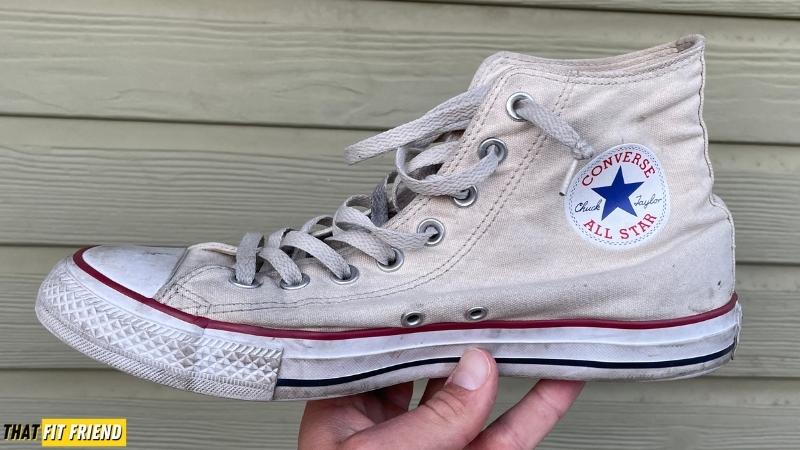


Wide Feet (E+ width)
- Vans Sk8-Hi: True to size, but go WIDE.
- Converse Chuck Taylor All-Star: Go down a half-size and go wide. Go true to size if your feet typically run on the longer end for your normal TTS.
- Nike Blazer Mid: True to size, but you may want to pass if you’re 2E+. These run narrow.
Construction Details
Before you buy, it’s never a bad idea to have a full scope of the construction that goes into your shoes. Here are the core details that I think are worth knowing about these shoes.
Outsole
The Vans Sk8-Hi features a waffle tread pattern, which is signature for most Vans shoes. This tread has a relatively rugged feel to it and it tends to last a while when training in them and wearing them casually. Very rarely do you see Vans fail because of their outsole fading, and it’s typically the lamenation around the edges of where the vulcanized rubber meets the upper materials.



Converse Chuck Taylor All-Stars have a pseudo-rubber outsole. The very outside has a thin rubber layer, then there’s a cloth-like material underneath. As mentioned above, this is why Converse are able to ship as “slippers.” the rubber tread layer tends to last a few months before fading.
The Nike Blazer Mid has a full rubber outsole and features a herringbone tread pattern. This shoe’s outsole tends to last a long time and it has a ton of grip on different surfaces. I often liken it to basketball shoe outsoles.
Midsole
None of these shoes have formal “midsoles,” per se, but instead have sewn in soles or thicker insoles to provide comfort like the Converse Chuck Taylor.
The Vans Sk8-Hi has the thickest sewn in midsole and it sits comfortable over an inch regarding stack height. This shoe’s sole/midsole run the stiffest and tend to take the longest to break in.


Second is the Nike Blazer Mid which has a stack height that sits right around one inch, and it breaks in relatively fast. This is also what gives this shoe a great flexibility feeling in the gym.
Then last, we have the Converse with its dropin midsole. This model is the “lowest” to the ground. Again, if you take the dropin midsole, you can get exceptionally close to the ground in the Converse. Its stack height sits at less than half an inch when removed.
Upper
The Vans Sk8 Hi and Nike Blazer Mid have the heaviest uppers and will both lack breathability in the gym, especially if you train in warmer climates.
The Blazer Mid features a timeless leather-esque construction that has a good weight to it. This material is pretty heavy to the touch and it doesn’t crease super easily, and that’s also perk of this shoe in the gym as it holds its shape pretty well. There are suede overlays around the toe box and Nike branding.


The Vans Sk8 Hi has the second heaviest of this bunch. It’s built with mesh and canvas materials. The forefoot and midfoot have layered mesh, canvas, and textile overlays and the boot has a padded material that provides additional structure and support. From a training context, if you like extra boot support, grab the Sk8-Hi or Blazer Mid.
The Converse Chuck Taylor All-Star is built with a lighter-weight canvas with a rubber toe cap. It has the most breathability and flexibility of this bunch. If you crank the laces tight you can get a little more boot security in the High-Top All Stars, but they won’t have nearly as much as the heavier leather and padded mesh in the Nike and Vans.
Laces and Tongue
None of these shoes have gusseted tongues, which can actually be a factor for lifters like myself who like to wear their shoes looser sometimes. If you’re similar, the Vans and Nike’s tongues will lay a little more true with a looser lacing setup. The Converse tongue can slide a bunch if you don’t fill the boot and have them a little tighter.

The Blazer Mid and Sk8-Hi have foam and padded mesh tongues, respectively, and the Converse’s tongue is built with a thin canvas. In general, these shoes’ tongues don’t cause a ton of friction when lifting, but it can happen in some cases — however, it’s not as bad as other high-top shoes like the NOBULL Outwork High-Top.
All of these shoes feature traditional lacing systems, and their eyelet counts are as follows:
- Converse: 8
- Vans: 8
- Nike: 9

Shop These Shoes
Which Should You Go With?
If you want a flatter shoe with a more anchored feel while training with good durability, you can’t go wrong with the Vans Sk8-Hi. Just keep in mind that these do lack a bit of versatility and breathability.
For more versatility, durability, and some zest for casual wear, it’s tough to fault the Blazer Mid. This model’s lower heel-to-toe drop tends to work great for most training contexts, and it has the most flexibility.
The Converse Chuck Taylor All-Star will be the best option for the budget shopper and powerlifter who plans to take the insole out for deadlifts. This model is tried and true, for the most part. I do think the saying, “They don’t make them like they used to,” can apply to the newer Converse in the gym.
If you have additional questions on this article, hit me in the comments below or reach out via Instagram!

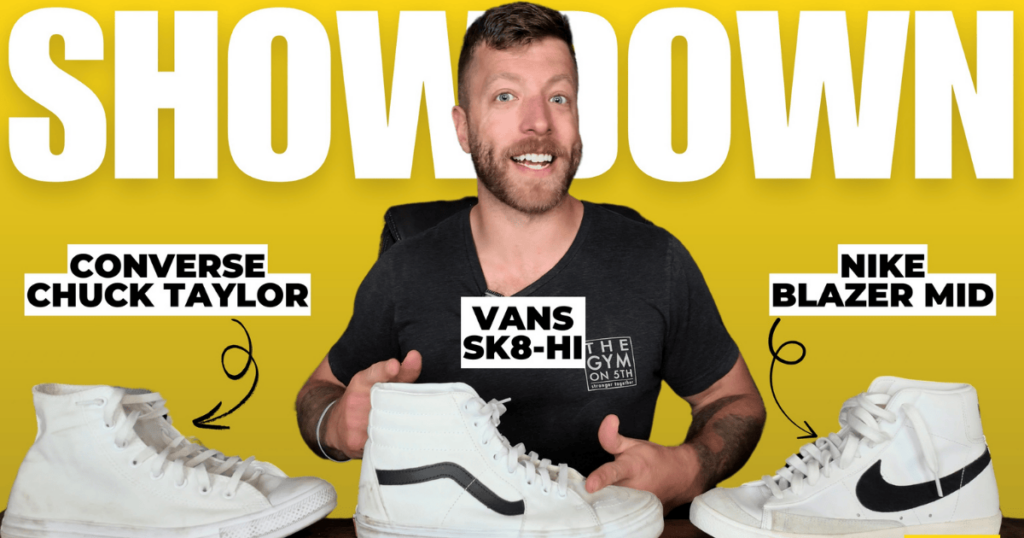





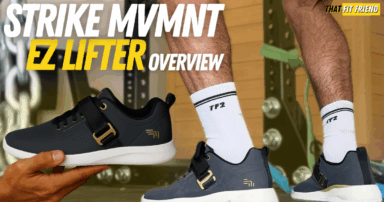
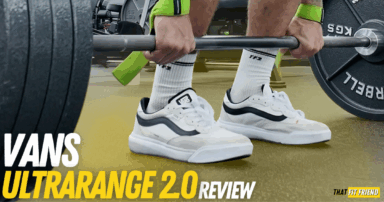
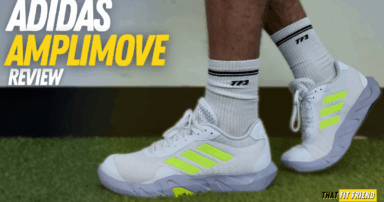
Add a Comment